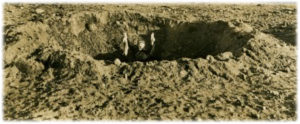On the night of 20th January 1941, at the height of the Blitz and under a Druid Moon, a German bomb fell on the edges of the village of Chobham, in Surrey. Whilst no-one was injured, something awful was revealed. The details of what was found have been kept secret and official information is very hard to uncover. Little evidence of the event exists anymore.
The parish church (St Lawrence, Chobham) holds an archive of local history. This comprehensive library holds every imaginable detail of what has ever occurred in the ancient village; every detail other than what was uncovered in January 1941. There is a brief mention in the Vicar’s (Reverend Christopher Bessing) personal ledger of a ‘stray enemy bomb’ which ‘fell near the mill without exploding, resulting in the whole area being cordoned off for some time.’ That is everything that can be found locally.
However, there were many witnesses at the time and the discovery gave truth to the ancient rumours and stories passed down by generations of villagers. Wartime secrecy and the prohibition of press that might affect morale meant that the story never got out beyond local stories, which have almost completely faded away.
There have always been tales of something unmentionable in the distant history of the village, something unholy, something evil. Over the years, the tales have become muddled and diluted, with stories of burial grounds and others of betrayals and massacres. The truth is so horrible that it is not so surprising that it is still denied and rarely mentioned.
That day, in the midst of the darkest hours of the war, the explosion near Town Mill opened the way into a five-pointed excavation. The centre of the works was an open chamber about ten feet deep, circular, with five short passages leading to the five points, equally spaced. The central chamber was dominated by the remains of what seemed once to have been a stone pillar, highly ornate, with runic symbols and detailed pictograms. Whilst the central chamber had clearly once been open to the air, the five passages where more like tunnels, low and closed-in. It was what was found inside the five tunnels that began to reveal the true horror of the discovery.
Bones. Many, many, small, human bones.
Each of the tunnels was strewn, almost carpeted, with the bones of young children. There was every kind of bone except none of the bodies had skulls. The tunnels were carefully set out as ossuaries, with the bones clearly positioned purposefully.
Most disturbing of all was the fact that most of the fingertip bones (distal phalanges) found were worn down at their very tips and the surrounding walls were covered with what appeared to be thousands of tiny scratch marks, suggesting the victims of the pit died within it and their heads removed later.
Further excavation revealed separate chambers at the end of the passages, inside which were piles of tightly packed skulls – many more than the other ossuaries suggested.
Higham Woodcote (seen above, inside the initial crater), owner of the land on which the discovery was made, was at first intrigued to see something of interest uncovered by the bomb. However, once the true nature of the site was realised, he was deeply troubled. He sold up his property in the village and left Chobham forever. It has proven very difficult to find out what later happened to him, but there is mention of a ‘Mr H Woodcote’ being cremated at council expense, in North Wales in 1963.

